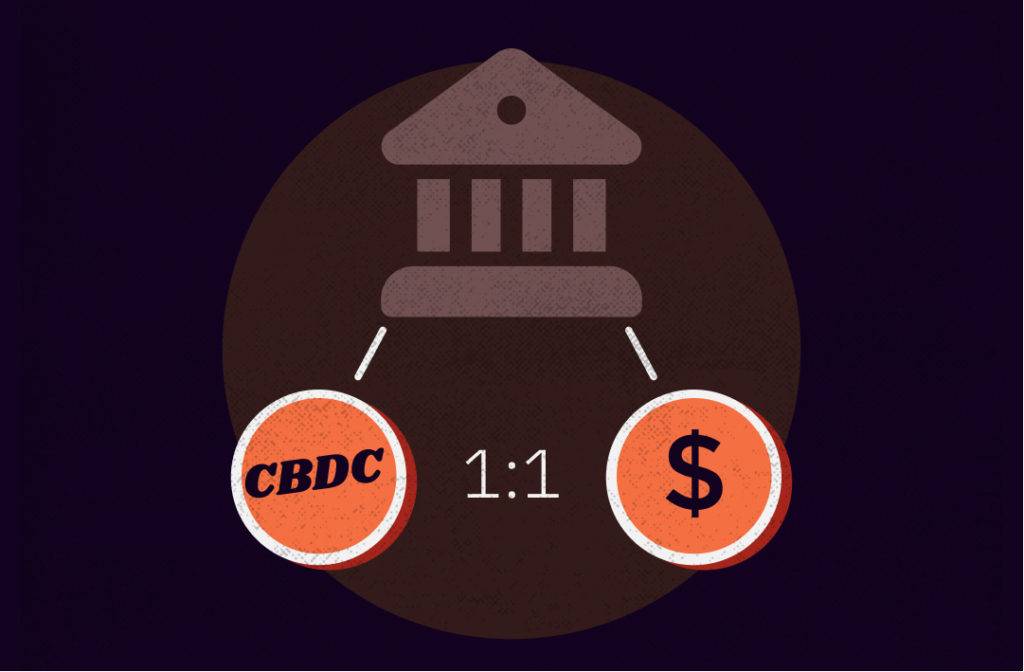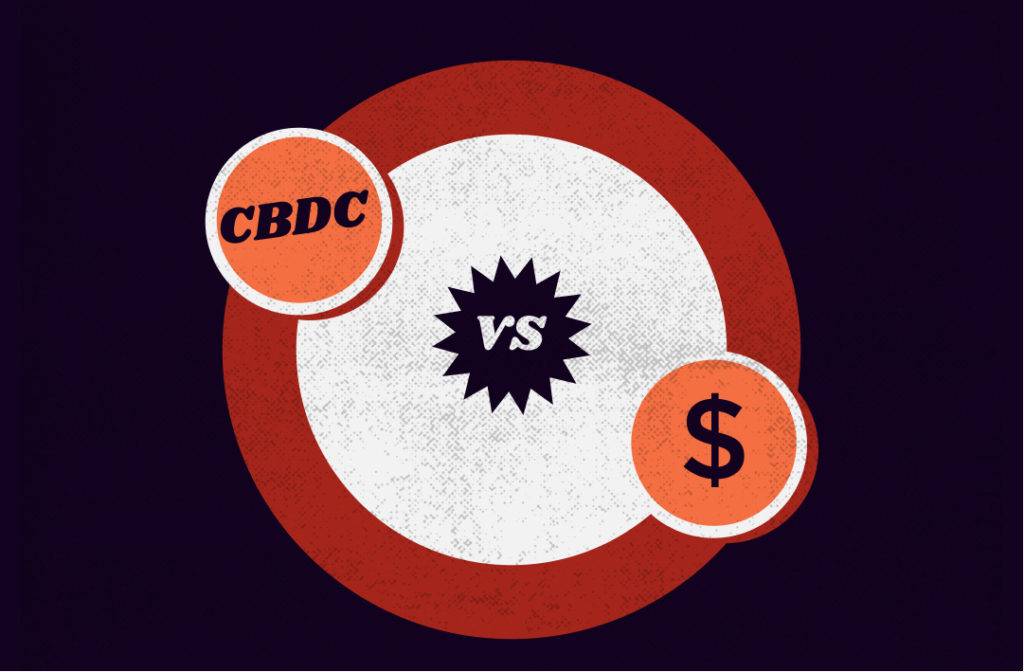What Is a Central Bank Digital Currency (CBDC)?
 A central bank digital currency (CBDC) is a blockchain-based cryptocurrency that is controlled by a central bank. Fiat and CBDC money are interchangeable at a ratio of 1 to 1. Or in other words, a CBDC is the state analog of stablecoin, guaranteed by the existing money supply of the national currency.
A central bank digital currency (CBDC) is a blockchain-based cryptocurrency that is controlled by a central bank. Fiat and CBDC money are interchangeable at a ratio of 1 to 1. Or in other words, a CBDC is the state analog of stablecoin, guaranteed by the existing money supply of the national currency.
How Do CBDCs Differ from Conventional Money?
The state central bank issues digital currency and conventional money. The main difference is the ability to digitize CBDC transactions completely. This implies several advantages:
- higher transaction speeds;
- tangible reduction of fees;
- automation of payment systems, increase of their usability.
 Blockchain makes all financial transactions transparent. The government gets the opportunity to control the turnover of digital funds, including internal budget expenditures. As a result, there should be anti-money laundering tools, anti-corruption means, etc.
Blockchain makes all financial transactions transparent. The government gets the opportunity to control the turnover of digital funds, including internal budget expenditures. As a result, there should be anti-money laundering tools, anti-corruption means, etc.
How Do CBDCs Differ from Other Cryptocurrencies?
The main difference is the centralized nature of CBDCs, regulated by the central bank. It provides digital currency supply and has tools to handle transactions using it. The technical support of such currency is also carried out centrally, and there is no need for mining.
Traditional cryptocurrencies like Bitcoin and others involve complete decentralization and lack of control by any regulatory authority.
How Are CBDCs Used?
CBDCs can perform different functions and have different respective impacts on the financial system of the country:
- Cash. Citizens are gradually switching from fiat money to their digital counterparts. The monetary policy of the central bank remains practically unchanged.
- Payment system. Competition in the payments market will increase, and it will be easier for citizens to pay for goods and services. The role of the central bank will increase; the monetary system will be more digitized.
- Deposits. The use of CBDCs as deposits will significantly change the financial policy. The role of commercial banks and their impact on the economy will change dramatically.

CBDCs may be intended strictly for financial institutions – such a policy aims to strengthen and grow the economy as a whole, but financial policy within the country is virtually unaffected. Thus, the specifics of a central bank’s use of digital currency depend directly on the problems to be solved by CBDCs.
Impact of CBDCs on the Financial System
Among the main factors of CBDCs’ impact, economists note the following:
- Financial inclusion. The inclusion of crypto technology in the sphere of central banking permits fee reductions, the expansion of the payment infrastructure and a deeper integration of the banking system into the digitized economy.
- Increasing fiscal policy efficiency. Blockchain technologies will expand the tools of supervisory bodies, increase cash flow transparency, and improve the quality of collection and analysis of macroeconomic indicators.
- Stability. It is assumed to stabilize the financial system due to the factors mentioned above. Also, stability is promoted by increasing the central banks’ competitiveness compared to cryptocurrencies and large technological corporations.
- Stimulation of national currency usage. This is especially crucial in countries whose economies are excessively tied to the U.S. dollar.
The emphasis varies depending on the type of economy. In advanced economies, a CBDC is seen by central banks primarily in the context of domestic stability, internal payment security, and their resilience to failure. For developing economies, financial inclusion is more critical. For commercial banks, the main benefits of CBDCs are reduced commissions for cross-border transfers, improved bank liquidity, and lowered settlement risks.
Different Types of CBDCs
CBDCs can be classified by infrastructure and technological features, by access conditions and the degree of anonymity, by the area of application, etc. But the main difference in various types of CBDCs today lies in their “architecture.”
There are two basic types of “architecture”: wholesale (a.k.a. commercial or direct) and retail (retail/general purpose).

Wholesale (commercial) CBDCs (W-CBDC) are payment systems controlled by the central bank. This system is available only to financial institutions and organizations that keep money in the central bank accounts. The use of digital currencies of this type is limited to large interbank transactions in international trade (in transactions of this type, the central bank usually acts as a guarantor).
Retail CBDCs are digital currencies with free circulation in the domestic market. They are divided into three types according to their characteristics: indirect (synthetic), intermediary and hybrid. Different types of retail digital currencies imply varying degrees of central bank involvement in the technological processes of their operation and maintenance. It is retail CBDCs that are a full-fledged analog of fiat currencies.
Which Countries Have CBDCs?
 More than 20 countries around the world are working on the creation of a national cryptocurrency. However, China is leading the way in CBDC implementation. According to the Chinese authorities, the free circulation of the national digital currency will start with the opening of the Winter Olympic Games in Beijing in 2022. In this case, since May 2020, the “digital yuan” (DCEP) has already been partially implemented in the Chinese economy. The largest user services with an audience within the millions have been involved in its testing.
More than 20 countries around the world are working on the creation of a national cryptocurrency. However, China is leading the way in CBDC implementation. According to the Chinese authorities, the free circulation of the national digital currency will start with the opening of the Winter Olympic Games in Beijing in 2022. In this case, since May 2020, the “digital yuan” (DCEP) has already been partially implemented in the Chinese economy. The largest user services with an audience within the millions have been involved in its testing.
The United States, Japan, the EU countries (Sweden, France, Spain, the Netherlands, etc.), Venezuela, and others are actively creating CBDCs. In Russia, there are no such plans. Instead, Russian financiers see an alternative in the system of instant payments of the Central Bank.
Experts agree that the development of CBDCs is a fundamental change in the monetary system, which will completely reshape the global economy over the next 10 years.










